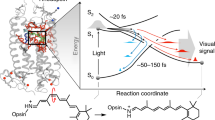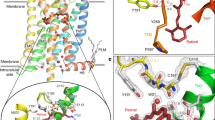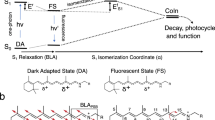Abstract
RETINAL photoreceptors are noisy. They generate discrete electrical events in the dark indistinguishable from those evoked by light1,2 and thereby limit visual sensitivity at low levels of illumination3,4. The random spontaneous events are strongly temperature-dependent and have been attributed to thermal isomerizations of the vitamin A chromophore of rhodopsin, the light-sensitive molecule in photoreceptors1,5,6. But thermal generation of dark events in both vertebrate and invertebrate photoreceptors requires activation energies in the range of 23 to 27 kcal mol−1, which are significantly less than the energy barrier of 45 kcal mol −1 for photoisomerization of the chromophore of native rhodopsin7–9. We propose that photoreceptor noise results from the thermal isomeriz-ation of a relatively unstable form of rhodopsin, one in which the Schiff-base linkage between the chromophore and protein is unprotonated. This molecular mechanism is supported by both theoretical calculations of the properties of rhodopsin and experimental measurements of the properties of photoreceptor noise.
This is a preview of subscription content, access via your institution
Access options
Subscribe to this journal
Receive 51 print issues and online access
$199.00 per year
only $3.90 per issue
Buy this article
- Purchase on Springer Link
- Instant access to full article PDF
Prices may be subject to local taxes which are calculated during checkout
Similar content being viewed by others
References
Baylor, D. A., Matthews, G. & Yau, K. W. J. Physiol. 309, 591–621 (1980).
Yeandle, S. Am. J. Ophthalmol. 46, 82–87 (1958).
Copenhagen, D. R., Donner, K. & Reuter, T. J. J. Physiol. 393, 667–680 (1987).
Aho, A. C., Donner, K., Hyden, C., Larsen, L. O. & Reuter, T. Nature 334, 348–350 (1988).
Barlow, H. B. J. Opt. Soc. Am. 46, 634–639 (1956).
Barlow, H. B. Nature 334, 296–297 (1988).
Birge, R. R. Biochim. biophys. Acta 1016, 293–327 (1990).
Tallent, J. R., Hyde, E. W., Findsen, L. A., Fox, G. C. & Birge, R. R. J. Am. chem. Soc. 114, 1581–1592 (1992).
Schick, G. A., Cooper, T. M., Holloway, R. A., Murray, L. P. & Birge, R. R. Biochemistry 26, 2556–2562 (1987).
Ashmore, J. F. & Falk, G. J. Physiol. 332, 272–297 (1977).
Hubbard, R. J. biol. Chem. 241, 1814–1818 (1966).
Longstaff, C., Calhoon, R. D. & Rando, R. R. Proc. natn. Acad. Sci. U.S.A. 83, 4209–4213 (1986).
Sakmar, T. P., Franke, R. R. & Khorana, H. G. Proc. natn. Acad. Sci. U.S.A. 86, 8309–8313 (1989).
Fahmy, K. & Sakmar, T. P. Biochemistry 32, 9165–9171 (1993).
Barlow, R. B. Jr, Kaplan, E., Renninger, G. H. & Saito, T. J. gen. Physiol. 89, 353–378 (1987).
Kaplan, E. & Barlow, R. B. Jr Nature 286, 393–395 (1980).
Birge, R. R. Biophys. J. 64, 1371–1372 (1993).
Corson, D. W. & Fein, A. Brain Res. 193, 558–561 (1980).
Lisman, J. E. & Strong, L. A. J. gen. Physiol. 73, 219–243 (1980).
Chesler, M. Prog. Neurobiol. 34, 401–427 (1990).
Fahrenbach, W. H. Z. zellforsch. mikrosk. anat. 93, 451–483 (1969).
Schneider, M. H., Lehman, H. K. & Barlow, R. B. Jr, Invest. Ophth. Vis. Sci. 28, (suppl.) 186 (1987).
Kass, L., Pelletier, J. L., Renninger, G. H. & Barlow, R. B. Jr J. comp. Physiol. A164, 95–105 (1988).
Barlow, R. B. Jr, Ireland, L. C. & Kass, L. Nature 296, 65–66 (1982).
Powers, M. K., Barlow, R. B. Jr & Kass, L. Visual Neurosci. 7, 179–189 (1991).
Baylor, D. A., Nunn, B. J. & Schnapf, J. L. J. Physiol. 357, 575–607 (1984).
Lillywhite, P. G. J. comp. Physiol. 122, 189–200 (1977).
Borgula, G. A., Karwoski, C. J. & Steinberg, R. H. Vision Res. 29, 1069–1077 (1989).
Oakley, B. II & Wen, R. J. Physiol. 419, 353–378 (1989).
Smith, W. C., Greenberg, R. M., Price, D. A. & Battelle, B. A. Invest. Ophth. Vis. Sci. 33, (suppl.) 1004 (1992).
Chesler, M. & Kraig, R. P. Am. J. Physiol. 253, R666–R670 (1987).
Barlow, R. B. Jr J. Neurosci. 3, 856–870 (1983).
Author information
Authors and Affiliations
Rights and permissions
About this article
Cite this article
Barlow, R., Birge, R., Kaplan, E. et al. On the molecular origin of photoreceptor noise. Nature 366, 64–66 (1993). https://doi.org/10.1038/366064a0
Received:
Accepted:
Issue Date:
DOI: https://doi.org/10.1038/366064a0
This article is cited by
-
Why choose 9-cis retinal for therapy of congenital stationary night blindness caused by G90D rhodopsin?
Theoretical Chemistry Accounts (2017)
-
Biophotons Contribute to Retinal Dark Noise
Neuroscience Bulletin (2016)
-
Origin of the low thermal isomerization rate of rhodopsin chromophore
Scientific Reports (2015)
-
Overexpression of rod photoreceptor glutamic acid rich protein 2 (GARP2) increases gain and slows recovery in mouse retina
Cell Communication and Signaling (2014)
-
Temperature effects on low-light vision in juvenile rockfish (Genus Sebastes) and consequences for habitat utilization
Journal of Comparative Physiology A (2007)
Comments
By submitting a comment you agree to abide by our Terms and Community Guidelines. If you find something abusive or that does not comply with our terms or guidelines please flag it as inappropriate.



